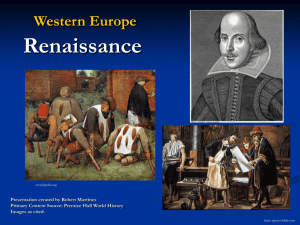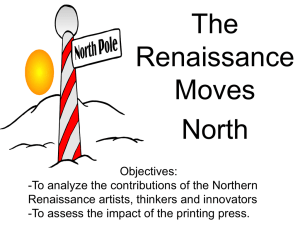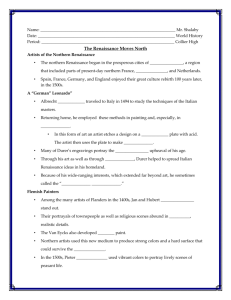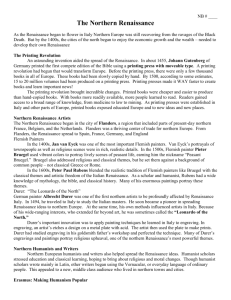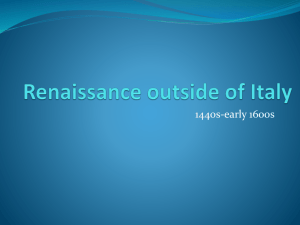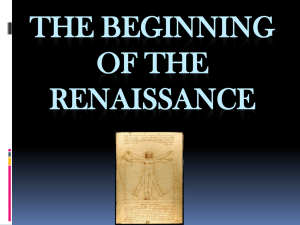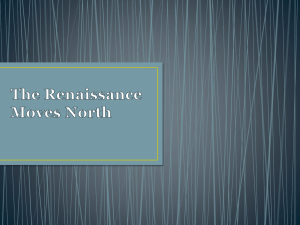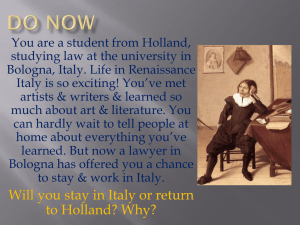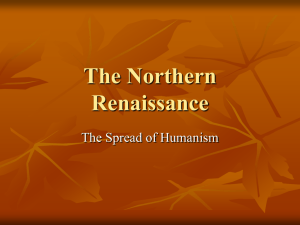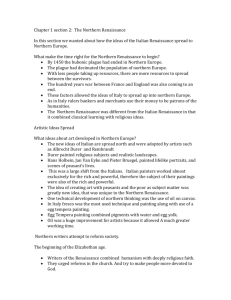Section 2 Renaissance Moves North Digital Presentation
advertisement
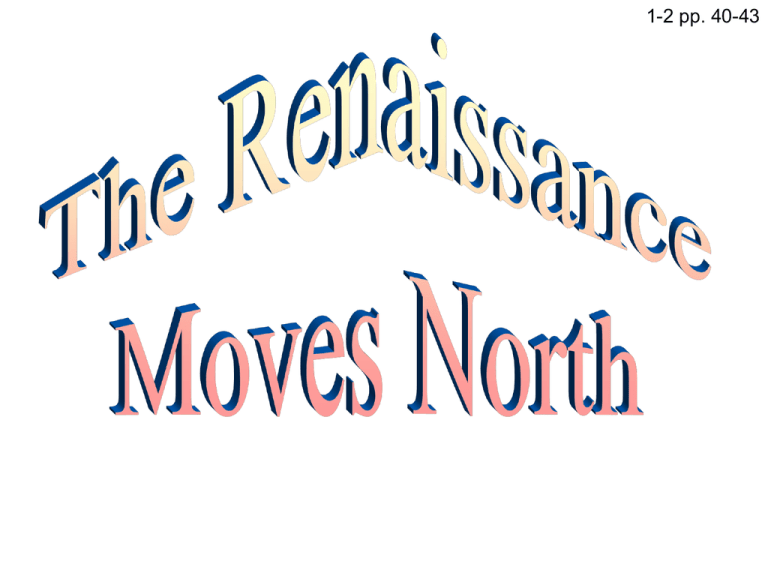
1-2 pp. 40-43 2 Artists of the Northern Renaissance The Northern Renaissance began in Flanders which includes parts of present day France, Belgium, and the Netherlands. About 100 years later Spain, France, Germany, and England began to move into the Renaissance period. A “German Leonardo” • Albrecht Durer [1471-1528] went to Italy to study with the Italian masters around 1494 • When he returned to Germany he became famous for his engravings [etched designs on metal plates using acid, then use this plate to make prints] that depicted religious upheaval • Durer helped spread Renaissance ideas in Germany through art and essays, because of his many talents he is referred to as the “German Leonardo” Flemish Painters • Jan [1385-1441] & Hubert [1366-1426] van Eyck developed oil paints which allowed for more vivid color and longer lasting paintings. They were famous for their paintings of every day people as well as religious events • Pieter Bruegel [1525-1569] used vibrant colors to paint scenes of peasant life. His work influenced later Flemish artists • 1600,s Peter Paul Rubens[1577-1640] blended realistic tradition with classical themes, many of his huge paintings portray pagan figures from the past Northern Humanists 2 Like their Italian counterparts, northern humanists stressed education and classical learning. At the same time, they believed that the revival of ancient learning should be used to bring about religious and moral reforms. • Desiderius Erasmus was a Dutch priest and humanist. H e produced a new Greek addition of the New Testament • He translated the bible into the vernacular [everyday language of ordinary people] He hated the belief of the CHURCH that the common person shouldn’t read the bible • People should be open minded and good to others. He hated corruption in the Church and called for reform. • His writing “The Praise of Folly” used humor to expose the ignorant and immoral behavior of the people of his day including church officials. Erasmus c. 1466-1536 Sir Thomas More • Thomas More was an English Humanist, and friend of Erasmus, who worked toward social reform. • In “Utopia” More wanted to create a society where no one is idle, all are educated, and justice is used to end crime rather than to eliminate the criminal. Thus UTOPIAN means ideal society 1478-1535 Writers for a New Audience • Scholars like More and Erasmus wrote mostly in Latin. In northern towns and cities, the growing middle class demanded new works in the vernacular. This audience particularly enjoyed dramatic tales and earthy comedies. Rabelais • Francois Rabelais [1483-1553] was a French Humanist who was a monk, physician, Greek scholar, and author • In “Gargantua and Pantagruel” Rabelais tells the story of two giants. It is a comic tale on the surface but really shows Rabelais views on religion, education, and other Shakespeare [1564-1616] • Obviously the most famous of the Playwrights from the Renaissance • English, wrote 37 plays between 1590-1616 • He wrote comedies, histories, and dramas • Shakespeare added around 1700 words to English vocabulary bedroom, lonely, generous, gloomy, heartsick, hurry, and sneak. • “Don Quixote” was written by Miguel de Cervantes [15471616] a Spanish Renaissance author • This tale mocks romantic notions of chivalry. It follows the adventures of Don Quixote, a foolish knight and his servant Sancho Panza Cervantes The Printing Revolution 2 A printing revolution took place when: In 1456, Johann Gutenberg [1397-1468] printed the Bible using the first printing press and printing inks. He improved on the paper and presses the far eastern civilizations had been using. • Printed books were cheaper and easier to produce. With books more readily available, more people learned to read. Readers gained access to a broad range of knowledge and ideas. • This new knowledge may have been a key factor in the religious changes that took place in the 1500’s
